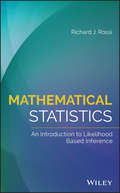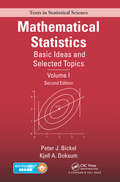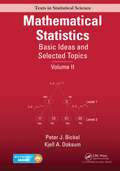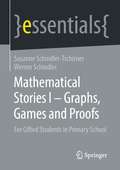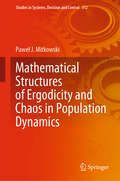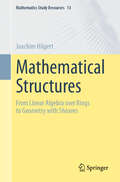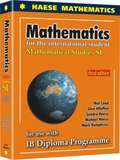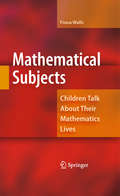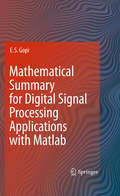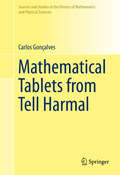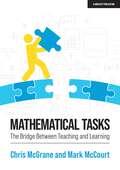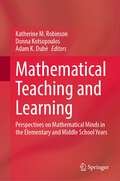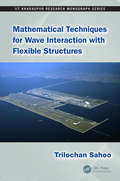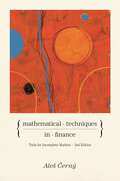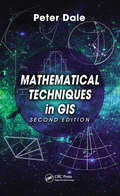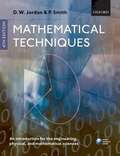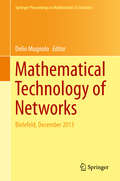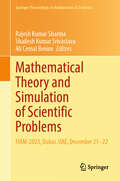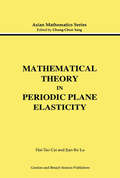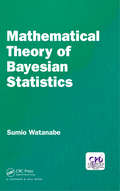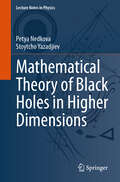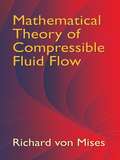- Table View
- List View
Mathematical Statistics: An Introduction to Likelihood Based Inference
by Richard J. RossiPresents a unified approach to parametric estimation, confidence intervals, hypothesis testing, and statistical modeling, which are uniquely based on the likelihood function This book addresses mathematical statistics for upper-undergraduates and first year graduate students, tying chapters on estimation, confidence intervals, hypothesis testing, and statistical models together to present a unifying focus on the likelihood function. It also emphasizes the important ideas in statistical modeling, such as sufficiency, exponential family distributions, and large sample properties. Mathematical Statistics: An Introduction to Likelihood Based Inference makes advanced topics accessible and understandable and covers many topics in more depth than typical mathematical statistics textbooks. It includes numerous examples, case studies, a large number of exercises ranging from drill and skill to extremely difficult problems, and many of the important theorems of mathematical statistics along with their proofs. In addition to the connected chapters mentioned above, Mathematical Statistics covers likelihood-based estimation, with emphasis on multidimensional parameter spaces and range dependent support. It also includes a chapter on confidence intervals, which contains examples of exact confidence intervals along with the standard large sample confidence intervals based on the MLE's and bootstrap confidence intervals. There’s also a chapter on parametric statistical models featuring sections on non-iid observations, linear regression, logistic regression, Poisson regression, and linear models. Prepares students with the tools needed to be successful in their future work in statistics data science Includes practical case studies including real-life data collected from Yellowstone National Park, the Donner party, and the Titanic voyage Emphasizes the important ideas to statistical modeling, such as sufficiency, exponential family distributions, and large sample properties Includes sections on Bayesian estimation and credible intervals Features examples, problems, and solutions Mathematical Statistics: An Introduction to Likelihood Based Inference is an ideal textbook for upper-undergraduate and graduate courses in probability, mathematical statistics, and/or statistical inference.
Mathematical Statistics: Basic Ideas and Selected Topics, Volume I, Second Edition (Chapman & Hall/CRC Texts in Statistical Science)
by Peter J. Bickel Kjell A. DoksumMathematical Statistics: Basic Ideas and Selected Topics, Volume I, Second Edition presents fundamental, classical statistical concepts at the doctorate level. It covers estimation, prediction, testing, confidence sets, Bayesian analysis, and the general approach of decision theory. This edition gives careful proofs of major results and explains ho
Mathematical Statistics: Basic Ideas and Selected Topics, Volume II (Chapman And Hall/crc Texts In Statistical Science Ser. #119)
by Peter J. Bickel Kjell A. DoksumMathematical Statistics: Basic Ideas and Selected Topics, Volume II presents important statistical concepts, methods, and tools not covered in the authors' previous volume. This second volume focuses on inference in non- and semiparametric models. It not only reexamines the procedures introduced in the first volume from a more sophisticated point o
Mathematical Stories I – Graphs, Games and Proofs: For Gifted Students in Primary School (essentials)
by Susanne Schindler-Tschirner Werner SchindlerWith the help of tried and tested, carefully elaborated learning units, the authors convey fundamental mathematical techniques in this essential, which are important far beyond primary school. In the present volume I, path problems and word puzzles are modeled and solved using undirected and directed graphs. Simple math games are systematically analyzed and the optimal strategies are determined. Students learn to gradually reduce difficult problems to simpler ones and to provide evidence in different contexts. The tasks encourage mathematical thinking, imagination and creativity. The detailed sample solutions are designed for non-mathematicians. This book is a translation of the original German 1st edition Mathematische Geschichten I – Graphen, Spiele und Beweise by Susanne Schindler-Tschirner and Werner Schindler, published by Springer Fachmedien Wiesbaden GmbH, part of Springer Nature in 2019. The translation was done with the help of artificial intelligence (machine translation by the service DeepL.com). A subsequent human revision was done primarily in terms of content, so that the book will read stylistically differently from a conventional translation. Springer Nature works continuously to further the development of tools for the production of books and on the related technologies to support the authors.
Mathematical Stories II - Recursion, Divisibility and Proofs: For Gifted Students in Primary School (essentials)
by Susanne Schindler-Tschirner Werner SchindlerUsing field-tested, carefully crafted units of study, the authors in this essential teach fundamental mathematical techniques that are relevant well beyond the elementary school years. In this Volume II, the Gaussian summation formula and a recursion formula are derived and applied. Tasks on divisibility, prime factors and divisors follow. For calculating with remainders, the modulo calculation is introduced and applied. Students learn to perform proofs in a variety of contexts. As in Volume I, "Graphs, Games, and Proofs," the tasks encourage mathematical thinking skills, imagination, and creativity. The detailed sample solutions are designed for non-mathematicians.This book is a translation of the original German 1st edition Mathematische Geschichten II – Rekursion, Teilbarkeit und Beweise by Susanne Schindler-Tschirner and Werner Schindler, published by Springer Fachmedien Wiesbaden GmbH, part of Springer Nature in 2019. The translation was done with the help of artificial intelligence (machine translation by the service DeepL.com). A subsequent human revision was done primarily in terms of content, so that the book will read stylistically differently from a conventional translation. Springer Nature works continuously to further the development of tools for the production of books and on the related technologies to support the authors.
Mathematical Structures and Applications: In Honor Of Mahouton Norbert Hounkonnou (STEAM-H: Science, Technology, Engineering, Agriculture, Mathematics & Health)
by Bourama Toni Toka DiaganaThis contributed volume features invited papers on current research and applications in mathematical structures. Featuring various disciplines in the mathematical sciences and physics, articles in this volume discuss fundamental scientific and mathematical concepts as well as their applications to topical problems. Special emphasis is placed on important methods, research directions and applications of analysis within and beyond each field. Covered topics include Metric operators and generalized hermiticity, Semi-frames, Hilbert-Schmidt operator, Symplectic affine action, Fractional Brownian motion, Walker Osserman metric, Nonlinear Maxwell equations, The Yukawa model, Heisenberg observables, Nonholonomic systems, neural networks, Seiberg-Witten invariants, photon-added coherent state, electrostatic double layers, and star products and functions. All contributions are from the participants of the conference held October 2016 in Cotonou, Benin in honor of Professor Mahouton Norbert Hounkonnou for his outstanding contributions to the mathematical and physical sciences and education. Accessible to graduate students and postdoctoral researchers, this volume is a useful resource to applied scientists, applied and pure mathematicians, and mathematical and theoretical physicists.
Mathematical Structures of Ergodicity and Chaos in Population Dynamics (Studies in Systems, Decision and Control #312)
by Paweł J. MitkowskiThis book concerns issues related to biomathematics, medicine, or cybernetics as practiced by engineers. Considered population dynamics models are still in the interest of researchers, and even this interest is increasing, especially now in the time of SARS-CoV-2 coronavirus pandemic, when models are intensively studied in order to help predict its behaviour within human population. The structures of population dynamics models and practical methods of finding their solutions are discussed. Finally, the hypothesis of the existence of non-trivial ergodic properties of the model of erythropoietic response dynamics formulated by A. Lasota in the form of delay differential equation with unimodal feedback is analysed. The research can be compared with actual medical data, as well as shows that the structures of population models can reflect the dynamic structures of reality.
Mathematical Structures: From Linear Algebra over Rings to Geometry with Sheaves (Mathematics Study Resources #13)
by Joachim HilgertThis textbook is intended to be accessible to any second-year undergraduate in mathematics who has attended courses on basic real analysis and linear algebra. It is meant to help students to appreciate the diverse specialized mathematics courses offered at their universities. Special emphasis is on similarities between mathematical fields and ways to compare them. The organizing principle is the concept of a mathematical structure which plays an important role in all areas of mathematics. The mathematical content used to explain the structural ideas covers in particular material that is typically taught in algebra and geometry courses. The discussion of ways to compare mathematical fields also provides introductions to categories and sheaves, whose ever-increasing role in modern mathematics suggests a more prominent role in teaching. The book is the English translation of the second edition of “Mathematische Strukturen” (Springer, 2024) written in German. The translation was done with the help of artificial intelligence. A subsequent human revision was done primarily in terms of content.
Mathematical Studies
by Mal Coad Sandra Haese Glen Whiffen Michael Haese Mark HumphriesMathematics for the International Student: Mathematical Studies SL has been written to embrace the syllabus for the two-year Mathematical Studies SL Course, to be first examined in 2014.
Mathematical Subjects
by Fiona WallsWe know the process by which children become social, moral, and creative beings, but when--and how--do they become mathematical beings? This thought-provoking volume follows ten children (ages seven through eighteen) in schools in New Zealand, England, Australia, Sweden, and an international school in Switzerland as they come to recognize the mathematical as part of their lives, their academic identities, and their identities as human beings. Through these students' experiences important themes emerge, including mathematics as work, a domain of learning, and an avenue for competition; mathematical ability as a key to how they are perceived by others; and the relationships between mathematics achievement and the larger social and academic picture. This comparative study of educational systems and academic development will inform readers in these and other salient areas: Theoretical bases for understanding children as mathematical subjects. Help in creating the mathematical self: tutoring and related programs. The roles of compulsory study and standardized assessment. Class and ethnic content in children's math narratives. The gendering of mathematical ability and activity. What children's math experience can teach us about teaching the subject. Children Talk about Their Mathematics Lives opens bold windows onto how young people learn and how disparities arise, making it a cutting-edge resource for researchers and libraries, graduates and teachers in mathematics education and early childhood education.
Mathematical Summary for Digital Signal Processing Applications with Matlab
by E. S. GopiMathematical summary for Digital Signal Processing Applications with Matlab consists of Mathematics which is not usually dealt in the DSP core subject, but used in DSP applications. Matlab programs with illustrations are given for the selective topics such as generation of Multivariate Gaussian distributed sample outcomes, Bacterial foraging algorithm, Newton's iteration, Steepest descent algorithm, etc. are given exclusively in the separate chapter. Also Mathematical summary for Digital Signal Processing Applications with Matlab is written in such a way that it is suitable for Non-Mathematical readers and is very much suitable for the beginners who are doing research in Digital Signal Processing.
Mathematical Tablets from Tell Harmal
by Carlos GonçalvesThis work offers a re-edition of twelve mathematical tablets from the site of Tell Harmal, in the borders of present-day Baghdad. In ancient times, Tell Harmal was Saduppûm, a city representative of the region of the Diyala river and of the kingdom of Esnunna, to which it belonged for a time. These twelve tablets were originally published in separate articles in the beginning of the 1950s and mostly contain solved problem texts. Some of the problems deal with abstract matters such as triangles and rectangles with no reference to daily life, while others are stated in explicitly empirical contexts, such as the transportation of a load of bricks, the size of a vessel, the number of men needed to build a wall and the acquisition of oil and lard. This new edition of the texts is the first to group them, and takes into account all the recent developments of the research in the history of Mesopotamian mathematics. Its introductory chapters are directed to readers interested in an overview of the mathematical contents of these tablets and the language issues involved in their interpretation, while a chapter of synthesis discusses the ways history of mathematics has typically dealt with the mathematical evidence and inquires how and to what degree mathematical tablets can be made part of a picture of the larger social context. Furthermore, the volume contributes to a geography of the Old Babylonian mathematical practices, by evidencing that scribes at Saduppûm made use of cultural material that was locally available. The edited texts are accompanied by translations, philological, and mathematical commentaries.
Mathematical Tasks: The Bridge Between Teaching and Learning
by Mark McCourt Chris McGraneIf we want our pupils to develop fluency, understanding and the ability to solve complex problems, then it is vital that teachers develop the ability to select, adapt and design appropriate mathematical tasks. In 'Mathematical Tasks: The Bridge Between Teaching and Learning', Chris McGrane and Mark McCourt a range of practical approaches, strategies and principles behind the design and effective use of tasks in the mathematics classroom that lead to all pupils becoming successful learners. First-hand interviews with world class mathematics education experts and practicing teachers bring to life the ideas behind how tasks can act as a bridge between what the teacher wants the pupil to make sense of and what the pupil actually does makes sense of; tasks are how we enable pupils to enact mathematics - it is only by being mathematical that pupils can truly make connections across mathematical ideas and understand the bigger picture. This is a book for classroom teachers. Chris McGrane offers a range of practical examples for nurturing deep learning in mathematics that can be adapted and embedded in one's own classroom practice. This is also a book for those who are interested in the theory behind tasks. Chris and his interviewees examine the key role tasks play in shaping learning, teaching, curriculum and assessment. Suitable for teachers at all stages in their careers and teachers are encouraged to return to the book from time to time over the years to notice how their use of tasks in the classroom changes as they themselves develop.
Mathematical Tasks: The Bridge Between Teaching and Learning
by Mark McCourt Chris McGraneIf we want our pupils to develop fluency, understanding and the ability to solve complex problems, then it is vital that teachers develop the ability to select, adapt and design appropriate mathematical tasks. In 'Mathematical Tasks: The Bridge Between Teaching and Learning', Chris McGrane and Mark McCourt a range of practical approaches, strategies and principles behind the design and effective use of tasks in the mathematics classroom that lead to all pupils becoming successful learners. First-hand interviews with world class mathematics education experts and practicing teachers bring to life the ideas behind how tasks can act as a bridge between what the teacher wants the pupil to make sense of and what the pupil actually does makes sense of; tasks are how we enable pupils to enact mathematics - it is only by being mathematical that pupils can truly make connections across mathematical ideas and understand the bigger picture. This is a book for classroom teachers. Chris McGrane offers a range of practical examples for nurturing deep learning in mathematics that can be adapted and embedded in one's own classroom practice. This is also a book for those who are interested in the theory behind tasks. Chris and his interviewees examine the key role tasks play in shaping learning, teaching, curriculum and assessment. Suitable for teachers at all stages in their careers and teachers are encouraged to return to the book from time to time over the years to notice how their use of tasks in the classroom changes as they themselves develop.
Mathematical Teaching and Learning: Perspectives on Mathematical Minds in the Elementary and Middle School Years
by Katherine M. Robinson Donna Kotsopoulos Adam K. DubéThis book focusses on teaching and learning in elementary and middle school mathematics and suggests practices for teachers to help children be successful mathematical thinkers. Contributions from diverse theoretical and disciplinary perspectives are explored. Topics include the roles of technology, language, and classroom discussion in mathematics learning, the use of creativity, visuals, and teachers’ physical gestures to enhance problem solving, inclusive educational activities to promote children’s mathematics understanding, how learning in the home can enhance children’s mathematical skills, the application of mathematics learning theories in designing effective teaching tools, and a discussion of how students, teachers, teacher educators, and school boards differentially approach elementary and middle school mathematics. This book and its companion, Mathematical Cognition and Understanding, take an interdisciplinary perspective to mathematical learning and development in the elementary and middle school years. The authors and perspectives in this book draw from education, neuroscience, developmental psychology, and cognitive psychology. The book will be relevant to scholars/educators in the field of mathematics education and also those in childhood development and cognition. Each chapter also includes practical tips and implications for parents as well as for educators and researchers.
Mathematical Techniques for Wave Interaction with Flexible Structures (IIT Kharagpur Research Monograph Series)
by Trilochan SahooMathematical Techniques for Wave Interaction with Flexible Structures is a thoughtful compilation of the various mathematical techniques used to deal with wave structure interaction problems. The book emphasizes unique determination of the solution for a class of physical problems associated with Laplace- or Helmholtz-type equations satisfying high
Mathematical Techniques in Finance: Tools for Incomplete Markets - Second Edition
by Ales CernýOriginally published in 2003, Mathematical Techniques in Finance has become a standard textbook for master's-level finance courses containing a significant quantitative element while also being suitable for finance PhD students. This fully revised second edition continues to offer a carefully crafted blend of numerical applications and theoretical grounding in economics, finance, and mathematics, and provides plenty of opportunities for students to practice applied mathematics and cutting-edge finance. Ales Cerný mixes tools from calculus, linear algebra, probability theory, numerical mathematics, and programming to analyze in an accessible way some of the most intriguing problems in financial economics. The textbook is the perfect hands-on introduction to asset pricing, optimal portfolio selection, risk measurement, and investment evaluation. The new edition includes the most recent research in the area of incomplete markets and unhedgeable risks, adds a chapter on finite difference methods, and thoroughly updates all bibliographic references. Eighty figures, over seventy examples, twenty-five simple ready-to-run computer programs, and several spreadsheets enhance the learning experience. All computer codes have been rewritten using MATLAB and online supplementary materials have been completely updated. A standard textbook for graduate finance courses Introduction to asset pricing, portfolio selection, risk measurement, and investment evaluation Detailed examples and MATLAB codes integrated throughout the text Exercises and summaries of main points conclude each chapter
Mathematical Techniques in GIS
by Peter DaleThe second edition of a bestseller, Mathematical Techniques in GIS demystifies the mathematics used in the manipulation of spatially related data. The author takes a step-by-step approach through the basics of arithmetic, algebra, geometry, trigonometry and calculus that underpin the management of such data. He then explores the use of matrices, de
Mathematical Techniques: An Introduction For The Engineering, Physical, And Mathematical Sciences
by Peter Smith Dominic JordanMathematical concepts and theories underpin engineering and many of the physical sciences. Yet many engineering and science students find math challenging and even intimidating. The fourth edition of Mathematical Techniques provides a complete course in mathematics, covering all the essential topics with which a physical sciences or engineering student should be familiar. By breaking the subject into small, modular chapters, the book introduces and builds on concepts in a progressive, carefully-layered way - always with an emphasis on using math to the best effect, rather than relying on theoretical proofs. With a huge array of end of chapter problems and new self-check questions, the fourth edition of Mathematical Techniques provides extensive opportunities for students to exercise and enhance their mathematical knowledge and skills.
Mathematical Technology of Networks
by Delio MugnoloDynamical models on graphs or random graphs are increasingly used in applied sciences as mathematical tools to study complex systems whose exact structure is too complicated to be known in detail. Besides its importance in applied sciences, the field is increasingly attracting the interest of mathematicians and theoretical physicists also because of the fundamental phenomena (synchronization, phase transitions etc. ) that can be studied in the relatively simple framework of dynamical models of random graphs. This volume was developed from the Mathematical Technology of Networks conference held in Bielefeld, Germany in December 2013. The conference was designed to bring together functional analysts, mathematical physicists, and experts in dynamical systems. The contributors to this volume explore the interplay between theoretical and applied aspects of discrete and continuous graphs. Their work helps to close the gap between different avenues of research on graphs, including metric graphs and ramified structures.
Mathematical Theory and Simulation of Scientific Problems: FIAM-2023, Dubai, UAE, December 21–22 (Springer Proceedings in Mathematics & Statistics #487)
by Rajesh Kumar Sharma Ali Cemal Benim Shailesh Kumar SrivastavaThis book contains select chapters of proceedings presented at the 6th International Conference on Frontiers in Industrial and Applied Mathematics (FIAM-2023), held at the Birla Institute of Technology and Science, Pilani-Dubai Campus, UAE, on 21–22 December 2023. It deals with mathematical theory and its applications to the various disciplines of engineering and sciences. The book illustrates the mathematical simulation of scientific problems and cutting-edge development in multiple branches of mathematics, including various computational and modeling techniques with case studies and concrete examples. The book is useful to graduate students, research scholars and professionals who are interested in the real applications of mathematics in the areas of computational and theoretical fluid dynamics, server queues, Lie group theory, fixed point theory, image processing, biomathematics, nonlinear dynamics and approximation theory.
Mathematical Theory in Periodic Plane Elasticity (Modern Analysis Series)
by Hai-Tao Cai Jian-Ke LuPresenting the mathematical theory of period problems in plane elasticity by methods of complex variables. The most general formulations of such problems are proposed under the assumption that the stresses are periodic and the displacements are quasi-periodic. The general expression of complex displacements are illustrated. Periodic welding problem
Mathematical Theory of Bayesian Statistics
by Sumio WatanabeMathematical Theory of Bayesian Statistics introduces the mathematical foundation of Bayesian inference which is well-known to be more accurate in many real-world problems than the maximum likelihood method. Recent research has uncovered several mathematical laws in Bayesian statistics, by which both the generalization loss and the marginal likelihood are estimated even if the posterior distribution cannot be approximated by any normal distribution. <P><P> Features <li>Explains Bayesian inference not subjectively but objectively. <li>Provides a mathematical framework for conventional Bayesian theorems. <li>Introduces and proves new theorems. <li>Cross validation and information criteria of Bayesian statistics are studied from the mathematical point of view. <li>Illustrates applications to several statistical problems, for example, model selection, hyperparameter optimization, and hypothesis tests. <li>This book provides basic introductions for students, researchers, and users of Bayesian statistics, as well as applied mathematicians. <P><P>Author <P><P>Sumio Watanabe is a professor of Department of Mathematical and Computing Science at Tokyo Institute of Technology. He studies the relationship between algebraic geometry and mathematical statistics.
Mathematical Theory of Black Holes in Higher Dimensions (Lecture Notes in Physics #1031)
by Petya Nedkova Stoytcho YazadjievThis book portraits the mathematical theory which lies behind black hole solutions in spacetimes with an extra dimension. Step by step the authors build a comprehensive picture of the main concepts and tools necessary to understand these geometries. In this way the book addresses questions like: How do we describe black holes in higher dimensions? How can we construct such geometries explicitly as exact solutions to the field equations? How many independent solutions can exist and how are they classified?The book concentrates on five-dimensional stationary and axisymmetric spacetimes in electro-vacuum and systematically introduces the most important black geometries which can arise in these settings. The authors follow the natural progress of the research area by initially describing the first results that were obtained intuitively and sparkled interest in the community. Then the elaborate mathematical techniques are introduced which allow to systematically construct exact black hole solutions. Topics like the integrability of the theory, the hidden symmetries of the field equations, the available Bäcklund transformations and solution generation techniques based on the inverse scattering method are covered. The last part of the book is devoted to uniqueness theorems showing how to classify the black hole spacetimes and distinguish the non-equivalent ones.The book is not just a mere collection of facts but a methodological description of the most important mathematical techniques and constructions in an active research area. The discussion is pedagogical and all the methods are demonstrated on a variety of examples. Most of the book is adapted to the level of a graduate student possessing a basic knowledge of general relativity and differential equations, and can serve as a practical guide for quickly acquiring the specific concepts and calculation techniques. Both authors have contributed to the research area by their original results, and share their own experience and perspective.
Mathematical Theory of Compressible Fluid Flow
by Richard Von MisesA pioneer in the fields of statistics and probability theory, Richard von Mises (1883-1953) made notable advances in boundary-layer-flow theory and airfoil design. This text on compressible flow, unfinished upon his sudden death, was subsequently completed in accordance with his plans, and von Mises' first three chapters were augmented with a survey of the theory of steady plane flow. Suitable as a text for advanced undergraduate and graduate students -- as well as a reference for professionals -- Mathematical Theory of Compressible Fluid Flow examines the fundamentals of high-speed flows, with detailed considerations of general theorems, conservation equations, waves, shocks, and nonisentropic flows.In this, the final work of his distinguished career, von Mises summarizes his extensive knowledge of a central branch of fluid mechanics. Characteristically, he pays particular attention to the basics, both conceptual and mathematical. The novel concept of a specifying equation clarifies the role of thermodynamics in the mechanics of compressible fluids. The general theory of characteristics receives a remarkably complete and simple treatment, with detailed applications, and the theory of shocks as asymptotic phenomena appears within the context of rational mechanics.
